Rothenburg - Fuessen
At the moment it is not quite clear how to continue
the tour. It would be an elegant opportunity to change to the attractive
bike trail of the river Altmuehl, which would be a comfortable tour
down the valley. But I persist on the Romantic Road to complete this route
from the begining to the end. But there are some hills ahead. We accept
our fate and start to push up the first hill. A tractor driver comes up
and states: "If you go on, there are three hills, if you go down there,
there is only one hill." We have a discussion.
You know the story of the donkey who starves between
two heaps of hay because he is unable to decide which of them he should
choose. We do not starve but continue to follow the hilly route for we
had not planned to ride on bypass- and national routes. Later we found
out, that we better had choosen the easier route, for the three hills really
come. Finally we reach the crow's nest Schillingsfürst up above
on a mountain. It is a small satisfaction that you find the Bavarian
Hawk Center and the Castle of the Counts of Hohenlohe up here.
We try to be more clever now and use the normal
road to Wörnitz. From there we use the national road B25, which
is the original Romantic Road for motorized vehicles. Therefore they have
signed the shields by Japanese letters too, the Japanese like romantic
scenes as we know (once they tried to buy the city of the historic german
town Buxtehude for a Disney-land-like amusement park...). On this
road we miss places with names like Wittum, Ratzendorf or Zischenhausen.
And there is a bike-museum at Zumhaus.
As we rush ahead with bended necks Heidi states:
"This is funny riding". Of course the brave constructors of the trace have
tried to planate away all hills and depressions for the roaring cars, that
they can shoot straight ahead. They never do this for cyclists at bike-trails.
May be it is better this way.
We roll towards Feuchtwangen, the destination
for today. At last we can leave the national road and reach the town through
damp meadows. "It is enough for today" we say and ask for a hotel at the
book shop on the market place. We are sent to the Gasthof Ballheimer
with an affiliate beer garden. The mood rises much more, when the tired
cyclist finds his home for the night, as everyone knows.
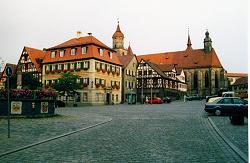
Feuchtwangen
Soon we leave off for a walk around. It is a nice
place here and not for the last time we end at the church. At Bavaria the
churches are always open, so you can look inside and read the following
words from an information sheet:
Dear visitor!
You have found your way to the Stiftskirche.
You had a look around and taken this sheet.
You are curious, want to know more and be
sure, that you missed nothing,
so this sheet can help you.
And it will introduce you to this building,
that is grown during the centuries...
The first two sentences can only be written by
a prophet.
| |
We suffer from hunger and rush to the affiliate
beer garden. This time there are various kinds of trees: a lime tree, an
ash tree, a plum tree, and - after questioning - a hornbeam tree (Carpinus
betulus, Hainbuche). And we have a tasty lever with spätzle (a kind
of Swabian noodles or pasta).
The evening hours are so warm and pleasant that
we have some beers more. Across the street a resident rumbles with a mechanical
sweep machine. This is something to laugh. But after we have entered our
beds we are forced to listen to the talking guests in the beer garden until
long after midnight. "They should lower the price" Heidi grunts.
Saturday, Feuchtwangen - Harburg, 72 km
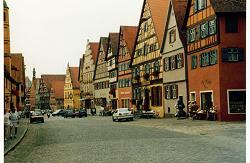
Dinkelsbuehl
We start at the national road again to avoid some
hills until we reach the valley of the Wörnitz. Running down
the damp valley we come to Dinkelsbühl. And what is this? City
walls, gates, towers, noble streets, framework, and a original ancient
atmosphere. Not as wrinkled as Rothenburg, more generous and wide. So let
us get a brochure again and read, that all this is true. So we will not
forget Dinkelsbühl. But there is another reason. One of us has difficulties
concerning his defecation. Therefore the pharmacy shops are invented and
we buy a medicine named Dulcolax. The strike-through-period is said
to be 5 hours.
| |
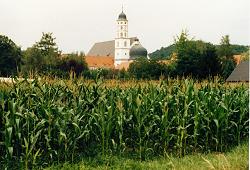
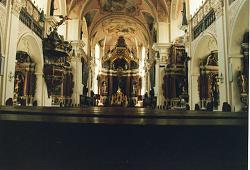
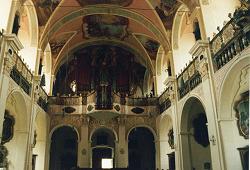
Kloster Maihingen
Thereafter we leave this beautiful town and head
towards Nördlingen at the B25. Near Minderoffingen we
enter the bike trail again and this is the right decision, for unexpectedly
we hit on the baroque monastery Maihingen. The guide does not mention
this place though you can roll yourself in gypsum ornaments, painted walls
and ceilings, golden frames and altars, blinding somehow.
We continue to Wallerstein but cannot inspect
this sufficiently. We concentrate to the Nördlinger Ries. This
is a crater from the crash of a meteorite 15 million years ago. Inside
of this crater you only can recognize the mountains at the edge ahead.
At Nördlingen with its circular structure
we are not the attentive visitors as we should be. This is because the
strike-through-period of Dinkelsbühl is over. First a toilet and then
straight out to the botany... Well, the botany is beautiful, fields of
maize are pretty. Fields of trefoil are not so good, especially if one
forgets to take off the white cap which is far to be seen... We have much
fun rolling along the edge of the Nördlinger Ries, the church of
Mönchsdeggingen
at the right side.
| |
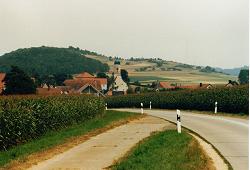
Near Kleinorsheim and Grossohrsheim...
Another story from the road. At the surface of
the street we wonder since some time about a white zigzagging stripe. Was
this the drunken driver of a marker vehicles as they use it to draw the
side- and middle lines? But there is an old man in a wheelchair watching
the landscape, let us ask him. The old man is very eager to tell the story.
| |
Yes, there was a marriage. But the bride had had
another cavalier some time before - "you know"? So someone got the idea
to draw this line from the home of the ex-cavalier to the bridegroom's
home, and this was done during the night at 3 am. "This is an old usage"
the man ends and I am lucky to have a story again. As we reach the next
village we can read the white painted letters: "You got bad luck". May
be this is due to the ex. Someway later: "Congratulations". May be this
is due to the bride.
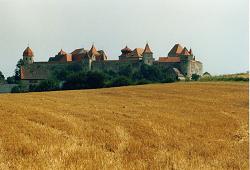
Harburg
Now we leave the two places named Kleinsorheim
and Großsorheim. The river Wörnitz was so kind to dig
a valley into the mountains to be able to leave the crater. For there was
the time of millions of years the work is done well. But if you choose
a path upside of the road you suddenly hit on a castle like from a romance
and this is the Harburg. "Will we go up there?" Heidi asks - but
no, we go down to the village named Harburg too to finish for today.
| |
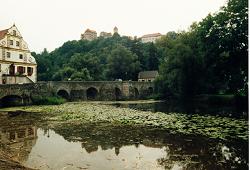
Bridge at Harburg
At a patrol station we ask for a hotel or pension
and are suggested to the "Cafe Käferlein". There we are and
get a nice room. The village is very narrow and glued to the slope between
the castle and the river Wörnitz. The old bridge was blasted during
World War II and thereafter rebuilt by the locals in its original state.
This is to be read at a sign. A level scale shows the height of the floods,
when the village was under water up to the inhabitant's noses.
| |
As we climb up the stairs to the chapel, the landlady
of the Cafe Käferlein shouts at us that we should do the 15-mins
ascent to the castle, for there one can sit, drink and eat in a romantic
manner. I can convince Heidi to master the airy path. At one spot you see
the houses of Harburg between your toes. At the wall of the fortress there
is a small gate and so you can easily conquer this bastion. There are some
attractions which I cannot translate: Vogtei, Diebesturm, Marstall,
and Kastenhaus. But our favourite goal is the Hotel Restaurant
Fürstliche Burgschenke.
There we sit down, this time beneath hawthorne
(Rotdorn). And let us state in advance: we will not rise so soon. Now we
suck in the atmosphere amidst the courtyard of the castle. There is a well
of 157 m depth. But there is no water in it, the service maid says, since
they have built a tunnel underneath. In earlier times all the traffic swapped
through the narrow village, nowadays it rolls beneath the castle.
Our bill finally shows (no translation):
3 Landsknechtbier
1 Weizen Dunkel
1 Jägerbraten
2 Salat v. Buffet
1 Lachsforellenfilet
At the table aside there sits a French couple
and they ask us for the deeper significance of Maultaschen and Spätzle.
We murmur something of noodles or so but better find it out: "learning
by doing". Some Japanese stroll around and make photographs of each other.
Finally we climb down the steep path back to the
Cafe Kaeferlein. At the inn on the other side of the street named Wirtshaus
Zum Straußen there is a birthday party. So we have the delight
to take share in the songs and music presented in honor of the birthday
child. I have noted some titles:
Auf der Heide blüht ein kleines Blümelein,
und das heißt: ERIKA!!
And here the German version of "Happy birthday
to you...":
Zum Geburtstag viel Glück,
Zum Geburtstag, liebe ERIKA,
Zum Geburtstag viel Glück.
You can guess now the name of the birthday child:
it is ERIKA.
The music band ends with:
Es gibt kein Bier auf Hawai...
Marina, Marina, Marina...
Oh when the Saints go marchin in...
Hey Postman give me answer, is there Memphis
Tennessie...
Then we have 10 pm and they close the windows.
Now the birthday table with the garden gnomes is no longer visible.
Sunday, Harburg - Friedberg, 73 km
We start with success and manage to avoid a hill
again. As we return to the bike path a man gives the advice "You must
go this way" - but that is the national road and we know it better. Then
there is a small chapel up above a hill named Wörnitzstein. Through
the foggy valley we come to Donauwörth. We have been there two years
ago at our tour along the Danube. At the mouth of the Wörnitz into
the Danube we have a rest.
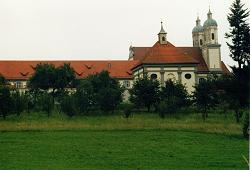
Kloster Holzen
The next part of the tour is not so interesting.
But then we arrive at Kloster Holzen. If you meet some nuns there
you should say "Grüß Gott". May be they will answer "We
will tell him". Now we enter the impressive church of the monastery.
| |
By the second glance you realize a macabre fact:
in some side-altars there are laid out figures looking like sculptures.
But in fact those are the rests of once living human beings. The skulls
are covered by a gau similar to a lady's neylon. In the information sheet
you find the names of those persons: the martyr St. Nikolinus, St.
Aurelia or St. Theodora. Another altar is decorated by a collection
of various bones and a mumified human heart as well. At the entrance there
is a guest book. Some people have written their personal desires in there
to ask the 14 Nothelfer or Auxiliary Saints:
Help me to pass the static-examination.
And help me to come together with Horst-Dieter
again, and let him forget Anette.
Shaking our heads we leave the place. From the
near monastery-inn we hear the profane noise of a solid card game coming
from shouts and the copious consumption of beer. The one of us with the
Strike-Through Period of yesterday looks for some near bushes and afterwards
can say: "Das Herrgöttle hat geholfen" (Bavarian phrase).
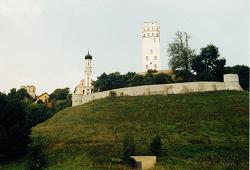
Now we have a nice path along the unknown river
Schmutter. At Biberbach there is the next religious memorial.
The pilgrim's church Hl. Kreuz is of impressive baroque again, and
in front of it there is an allegorical scene of the crucifixion. You are
tempted to donate a gymnastic award (sorry, this a very personal impression).
| |
Soon we reach the river Lech. In fact there
are two rivers. The one is a dead straight canal and filled with water
and the other is the natural rivver bed with white gravel banks and few
water. Between the both rivers there is a dam with the cycle path. The
lowland forest is felted by strong climber and twiner plants. Well known
is the bearbind (Ackerwinde) which we do not like in our garden.
Here it is nice especially in flourish.
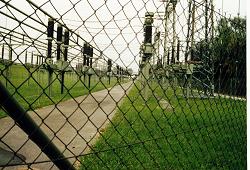
At a transformator station you can argue about
the tension and contrast between nature and technique. Near Augsburg
in the parks I get a puncture, the first one since two years. 15 minutes
later the matter is fixed by the spare tube.
| |
Now let's have a glance to
Augsburg. There seems to exist a lower and an upper town. The townhall
is built with its front to the upper and with its backside to the lower
town. We arrive at the lower (or back) part, so we have to bypass the stairs
and eventually end at the glorious Maximilianstraße. Just
across there is the place of the Fugger clan, recognizable by the
big painted emblem.
At the end of the street we find the church St.
Ulrich and Afra. The most important event at this place seems to be
the fact, that the present pope once had celebrated a high mass there.
At the shop you can buy lots of souvernirs remembering this event. On the
other side the clearness of this basilica is pleasant in contrary of all
the baroque trash. We cannot find out the merits of the saints Hl. Ulrich
and Hl. Afra who are buried at this place.
We have strained our cultural capacity now and
head for the town Friedberg, a picturesque place as is to be read
in our guide. It is the last occasion for an accomodation before a longish
deserted section along the Lech. Just up a hill and we enter the medieval
ensemble but do not record anything of this. We ask two women for a hotel.
"Oh this may be a problem here" one says. But there is the Gasthof zur
Linde and we have no difficulties.
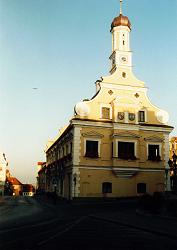
City Hall at Friedberg
The walk around is disappointing. The most buildings
are modern and only some broken relics of the city wall exist. A wooden
gallery on the top of this is preserved for several meters only. Then there
are two water towers and a modern church. We are somewhat depressive today.
We often look to our wrist watch for the china restaurant Panda will open
at 5.30 pm.
The evening is spent under lime trees in the beer
garden in front of our inn. This garden is very advantageous to the traffic
and we can listen to the techno-wum-wum and the roaring of the accelerating
motor bikes. But during the late evening things get better and we have
a nice sleep.
| |
Monday, Friedberg - Schongau, 85 km
We rise very early and at the breakfast we must
rise our feet because the charwoman is still at work. We (esp. Me) wait
for the first view of the alps. This will not work this morning because
a dense fog lies upon the meadows. At the Lech we hit on the Eisseekanal,
this was the olympic canoe course in 1972.
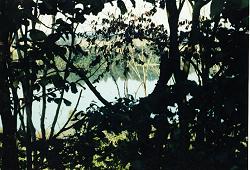
Then we cross woods and woods, pass the pondstage
(Staustufe) 23 to pondstage 18. Once you can study two kinds of meadow,
the one is dunged and intensively utilized, the color of the grass is green.
The other meadow is left alone to itself and has turned to meagre grass
with a high occurrance of species. The colour of this grass turns to yellow.
At pondstage 19 a sportive diversion is inserted:
the cycle path leads through the wall system of the ruins of the Haltenberg
castle. We have to carry the bikes to get through. To the river side the
slope falls down nearly vertically. So the area is named Small and
Big Redoubt (Schanze) and had been prehistoric fortifications.
| |
Now we come to Kaufering and sit in front
of the town hall. Up above this scene there resides the church and I jump
up the stairs. As I return I can announce "Another baroque church" and
moreover: "I have seen the Alps!".
Just outside of Kaufering we hit on the pilgrim's
chapel St. Leonhard. The chapel is surrounded by a strong chain
and we argue about what this could mean. At some displayed papers we can
read again:
Please, let it be like in the past with Herbert
and me...
In front of the chapel a yellow closed racing
lad curves around. May be he is lost, and then he turns to the road again
and heads for the uphill. And - we stop to breath - jumps off his bike
and pushes up the hill. So will we do, but not suited in yellow lycra race
dresses.
The next station is Landsberg and we can
hear the noise of the jetplanes of the army. They seem to practise their
fair weather experiences. Above Landsberg there is a fortress and a steep
downhill leads down to the market place. We twinkle around and turn to
the botany again. To conceal the heavy interventions to the nature by building
all these weirs and ponds they now claim out on signs, that this area will
not be influenced by human activities. To prove this you can admire a huge
boulder which has come down from the slope like a bomb in 1968. It is made
of lime and silicic and they call it "natural cement".
At pondstage 15 we meet a couple who can give
us a valuable advice. Instead of going up the next hill we should stay
to the path named R6. Soon we find ourselves on a bumpy and rocky gravel
path, so as fast as possible we escape to the next country road. The landscape
turns to look like the imagination of the "Allgäu" will promise
as there are green meadows with brown cows and fine villages with nice
churches.
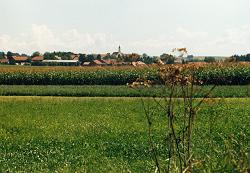
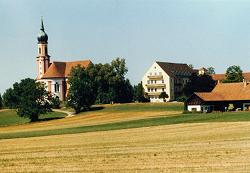 We sit on a bench and Heidi states "I could sit
here for an eternity". And at the next uphill she says in contrary: "This
is not my taste of landscape". I fall silent and am angry. Every cyclist
will know this situation that one is dependent of the feeling of the other
one. Things don't get better as we steeply run down to the river and afterwards
have to climb up to Schongau, the end for today. We get our room
at the Gasthof Sonne.
We sit on a bench and Heidi states "I could sit
here for an eternity". And at the next uphill she says in contrary: "This
is not my taste of landscape". I fall silent and am angry. Every cyclist
will know this situation that one is dependent of the feeling of the other
one. Things don't get better as we steeply run down to the river and afterwards
have to climb up to Schongau, the end for today. We get our room
at the Gasthof Sonne.
In Schongau we just find the atmosphere that we
had expected in vain the other day. We find a closed wall with gallery,
gates and towers and ancient buildings. The walk around is lead by Heidi
and the information brochure, for she has some fine reading glasses.
Finally we sit at the marketplace at the Alte
Post for a gipsy steak and trout "Müllerin". Heidi prefers potatoes
instead of Spätzle and we have to pay 1 DM "side-dish-change-tax".
The waiter is somewhat smugged and we have a inconclusive discussion. Finally
he gets a bakschisch of DM 1.80 and he smiles. May be he is not used to
higher gratitudes.
Thursday, Schongau - Füssen, 50 km
We have the next discussion: how to choose the route for the last section.
There are three choices: on the right side of the Lech, this is hilly.
The left side of the Lech, a nice route states the host of our pub. But
then we had to climb up the slope where we came down yesterday. And the
route on the B17 is the most comfortable. So we turn to the latter and
ride on in silence. I try to calibrate my speedometer by the sidestones
of the roead but it seems they are set in irregular distances.
But eventually we reach Steingaden and look with thriumph to
the mountains, where the cycle path winds its way. Baroque, Baroque, Baroque
- yes at the church of the monastery once again. And we must head for the
most famous - the world famous - Wieskirche in the height of 871
m. We come up there before the tourist crowds come in, admire the Baroque,
take some photos and read the petition papers. This time some are in Japanese
and those are secrets for us.
On the way back we have to cross a fenced pasture with about 30 cows.
While I am busy to close the entrance I watch Heidi riding along with hollow
back and eyes wide open. I run up to her and soon we reach the way out
without any catastrophe. As we are on the ground again we see left ahead
the greatest sensation for the romantic freaks: the two castles Neuschwanstein
and Hohenschwangau. Our romantic feelings are inverse proportional
to the number of busses and photo-clicking tourists. We mange to go up
to Hohenschwangau but then we resign to pay the entrance fee just to be
lead to parquets, inlays, tiled stoves and "Biedermeier" chairs. And Hohenschwanstein
is mere "Kitsch" for us - sorry for this.
Let us discuss our mood at this moment:
The last section is finished and the tension has gone,
Dark clouds are coming up and we are weather sensitive just now.
We head for Füssen and the railway station. 30 minutes later
we can leave for the Lake Constance, so we purchase the tickets
and happily accept that the bikes are free. In the train we meet a family
who had to pay for the bikes. It turns out, that they go just one station
out of the touristic zone and so have to pay the full fee. We turn our
thumbs for we feel so much more clever.
Now we must change the train at Kaufbeuren. From there we will
go for one station to Kempten and from there finally to Lindau.
The train at Kaufbeuren comes from Berlin and is named Interregio Alpsee.
As we enter the cycle compartment Miss conductor is waiting already. "You
must pay transport and reservation in this train" she says. I cannot believe
in this for we have purchased our tickets with the bikes free. The
conductor is writing already and all discussions do not help: it is printed
out at the ticket, the usage of Interregio trains is not free. We must
pay 12 DM for each bike, crunch the teeth and in melancholy remember the
Polish conductor from Stettin to Swinemünde (he had his own pocket...)
br>
Chapter 1 Wuerzburg - Rothenburg
Chapter 3 Bodensee